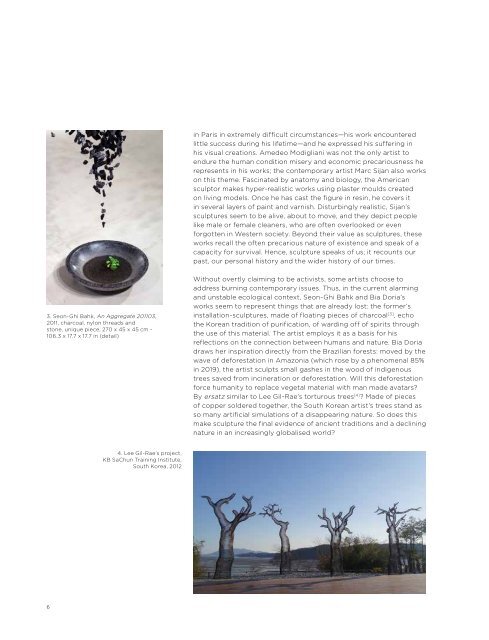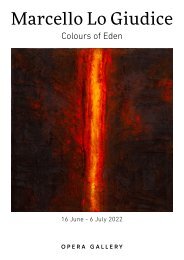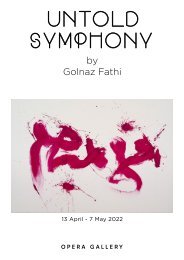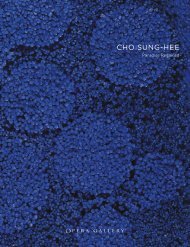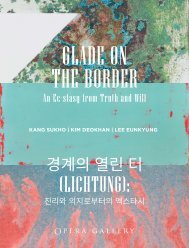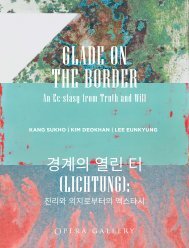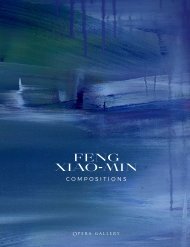"Sculptures"
Opera Gallery Dubai 18 - 31 March 2020
Opera Gallery Dubai
18 - 31 March 2020
Create successful ePaper yourself
Turn your PDF publications into a flip-book with our unique Google optimized e-Paper software.
3. Seon-Ghi Bahk, An Aggregate 201103,<br />
2011, charcoal, nylon threads and<br />
stone, unique piece, 270 x 45 x 45 cm -<br />
106.3 x 17.7 x 17.7 in (detail)<br />
in Paris in extremely difficult circumstances—his work encountered<br />
little success during his lifetime—and he expressed his suffering in<br />
his visual creations. Amedeo Modigliani was not the only artist to<br />
endure the human condition misery and economic precariousness he<br />
represents in his works; the contemporary artist Marc Sijan also works<br />
on this theme. Fascinated by anatomy and biology, the American<br />
sculptor makes hyper-realistic works using plaster moulds created<br />
on living models. Once he has cast the figure in resin, he covers it<br />
in several layers of paint and varnish. Disturbingly realistic, Sijan’s<br />
sculptures seem to be alive, about to move, and they depict people<br />
like male or female cleaners, who are often overlooked or even<br />
forgotten in Western society. Beyond their value as sculptures, these<br />
works recall the often precarious nature of existence and speak of a<br />
capacity for survival. Hence, sculpture speaks of us; it recounts our<br />
past, our personal history and the wider history of our times.<br />
Without overtly claiming to be activists, some artists choose to<br />
address burning contemporary issues. Thus, in the current alarming<br />
and unstable ecological context, Seon-Ghi Bahk and Bia Doria’s<br />
works seem to represent things that are already lost: the former’s<br />
installation-sculptures, made of floating pieces of charcoal [3] , echo<br />
the Korean tradition of purification, of warding off of spirits through<br />
the use of this material. The artist employs it as a basis for his<br />
reflections on the connection between humans and nature. Bia Doria<br />
draws her inspiration directly from the Brazilian forests: moved by the<br />
wave of deforestation in Amazonia (which rose by a phenomenal 85%<br />
in 2019), the artist sculpts small gashes in the wood of indigenous<br />
trees saved from incineration or deforestation. Will this deforestation<br />
force humanity to replace vegetal material with man made avatars?<br />
By ersatz similar to Lee Gil-Rae’s torturous trees [4] ? Made of pieces<br />
of copper soldered together, the South Korean artist’s trees stand as<br />
so many artificial simulations of a disappearing nature. So does this<br />
make sculpture the final evidence of ancient traditions and a declining<br />
nature in an increasingly globalised world?<br />
5. Pablo Atchugarry, La Pietà, 1982,<br />
Carrara marble<br />
While certain sculptors invite us to view our world through their<br />
works, we can also simply marvel at their art as an aesthetic<br />
expression. The construction and equilibrium that emanates from<br />
John Helton’s bronze sculptures contributes to embellishing our<br />
environment through its rhythm, spatial dynamics or even its gravity.<br />
Without being a clearly perceptible expression or language, the<br />
American artist’s sculptures infiltrate our collective unconscious, like<br />
the works of Henry Moore, to lastingly implant its shapes and forms<br />
into our conciousness. Famous for his monumental sculptures that<br />
dot public spaces in his homeland Uruguay, Pablo Atchugarry is<br />
captivated by materials, particularly marble. His sculptures explore<br />
the many ways of making it reflect, vibrate and respond to light.<br />
However, although he is better known for his abstract, vertically<br />
climbing works, Atchugarry anchors his sculptures in a sculptoral<br />
lineage: Michelangelo is his “conceptual mentor”. The famous Pietà,<br />
created by the Italian artist between 1498 and 1499, pervaded his<br />
mind to such an extent that Pablo Atchugarry has reinterpreted it<br />
innumerable times, with each representation more luminous than the<br />
last [5] . Unlike the Uruguayan sculptor who works on his material to<br />
display it in natural light, the British artist Anthony James seeks to<br />
explore the potential of artificial illumination. Constructed following<br />
precise mathematical principles, the artist’s sculptures are made<br />
of highly contemporary materials including LED [6] , and with this he<br />
states that art is timeless, but has multiple languages.<br />
As a language of survival, sculpture is also the language of the<br />
evidence of artistic, religious and popular traditions. It is the<br />
evidence of a conscience, the conscience of artists, who continue to<br />
warn us about the state of our world, and to teach and enthral us.<br />
4. Lee Gil-Rae’s project,<br />
KB SaChun Training Institute,<br />
South Korea, 2012<br />
6. Anthony James,<br />
70’’ Dodecahedron, 2019,<br />
powder coated stainless steel,<br />
glass and LED,<br />
177.8 x 177.8 cm - 70 x 70 in<br />
(detail)<br />
6<br />
7


